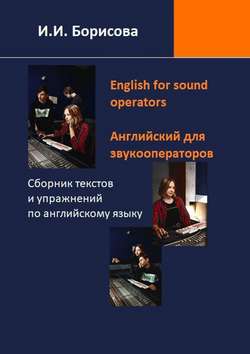Читать книгу English for sound operators. Английский язык для звукооператоров. Сборник текстов и упражнений по английскому языку - Ирина Ивановна Борисова - Страница 6
Unit 1
From the history of sound production
Text 2. Part 2. The 1950—1980s
ОглавлениеPRE-READING
1. What do you know about the following things:
– the arrival of the television;
– gimmicks used to make film watching more entertaining;
– home «hi-fi» arrangements
2. Look at the statement: «In the 1950s, the rise of the television became a real threat to the cinema.» Why do you think it happened? Work in groups of three or four and discuss your ideas. Report them to the class.
3. What do you think these words and word combinations mean?
Dominant source, public entertainment, film studios, technological advance, 3D glasses, auditorium, limit, economic factors, professionals, frustration, numerous technical problems, vinyl medium, aesthetic problems, full-range front channels, minimum number of speakers.
4. Name some more words and phrases you know relating to the subject.
SUBJECT AND LANGUAGE STUDY
Reading
5. Skim the reading passage to complete the statements.
The text considers…
It describes…
Each paragraph tells us…
6. Look through the passage and spot the answers to these questions.
1) What technological advances did the film studios introduce to fight the television?
2) Why did the idea of the four-channel configuration Quad fail?
3) When did the system 5.1 appear?
By the early 1950s, the movie certainly remained the dominant source of public entertainment. Nevertheless, the rise of the television became a real threat to the cinema. In fact, the growing popularity of the television influenced meaningfully the profits of the film industry. The film studios fought back desperately introducing one technological advance after another. Though some of them were just gimmicks to attract viewers (things like 3D glasses), other ones, such as the wide-screen cinemascope, eventually developed into significant improvements. Another achievement worth mentioning was a four-channel stereo (three front speakers accompanied by a switchable «effects» speaker). Soon after that, 70 mm 6-track film was invented. It had five front channels (left, left/center, center, center/right, right) plus a dedicated effects channel placed in the auditorium. However, mastering these technologies was limited by certain economic factors.
Home audio systems were also evolving greatly. By the 1960s, home «hi-fi» arrangements were all the rage. Stereo sound replaced monaural as a standard. The stereo recordings of a ping – pong ball bouncing between speakers stimulated the rise of today’s consumer surround sound.
In the early 1970s many professionals felt a kind of frustration at the scanty abilities of two speakers leading to research into the consumer surround sound which resulted in an analog four – channel configuration called Quad. It was a progressive idea going ahead of its time. It failed, however, beset by numerous technical (inability of the vinyl medium to carry four discrete signals without strong crosstalk and compromises in frequency response), economic (there were a lot of competing, non-compatible formats) and even aesthetic problems (the public did not completely understand the psychoacoustics of the four-channel sound.)
However, by the late 1970s, the first digital audio sets made an appearance at the market. The film industry was pushing forward its positions, too. Dolby Laboratories started their work at a matrixing system «Dolby Stereo» where three front speakers and an array of rear speakers received information through four channels derived from two stereo channels that were printed optically onto film. Dolby professionals also made an introduction of a separate «boom» subwoofer channel, or so called the «LFE channel» (which stands for Low Frequency Effects). It effectively increased dynamic range (the difference between the softest sound and the loudest sound perceived) in cinematic installations.
